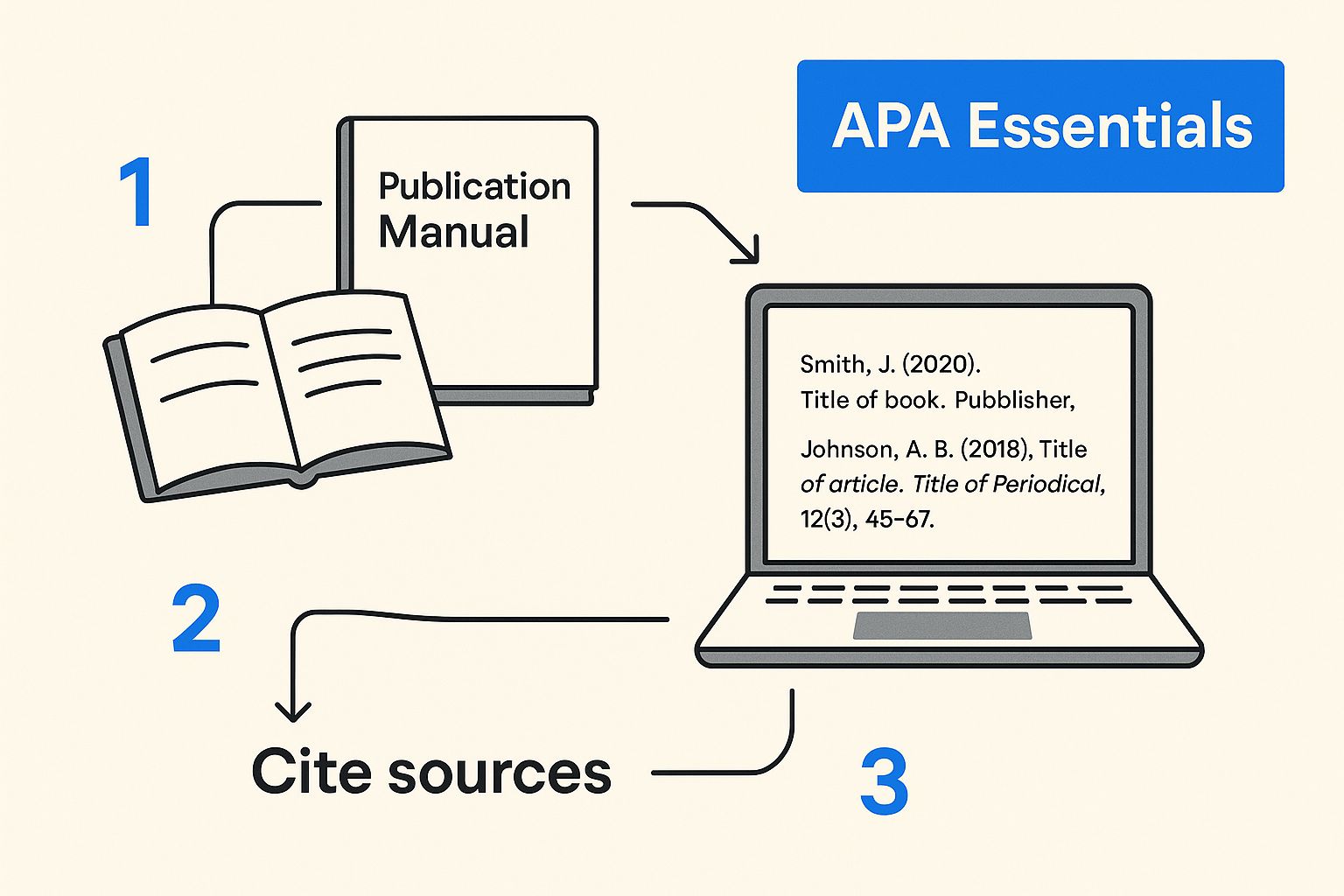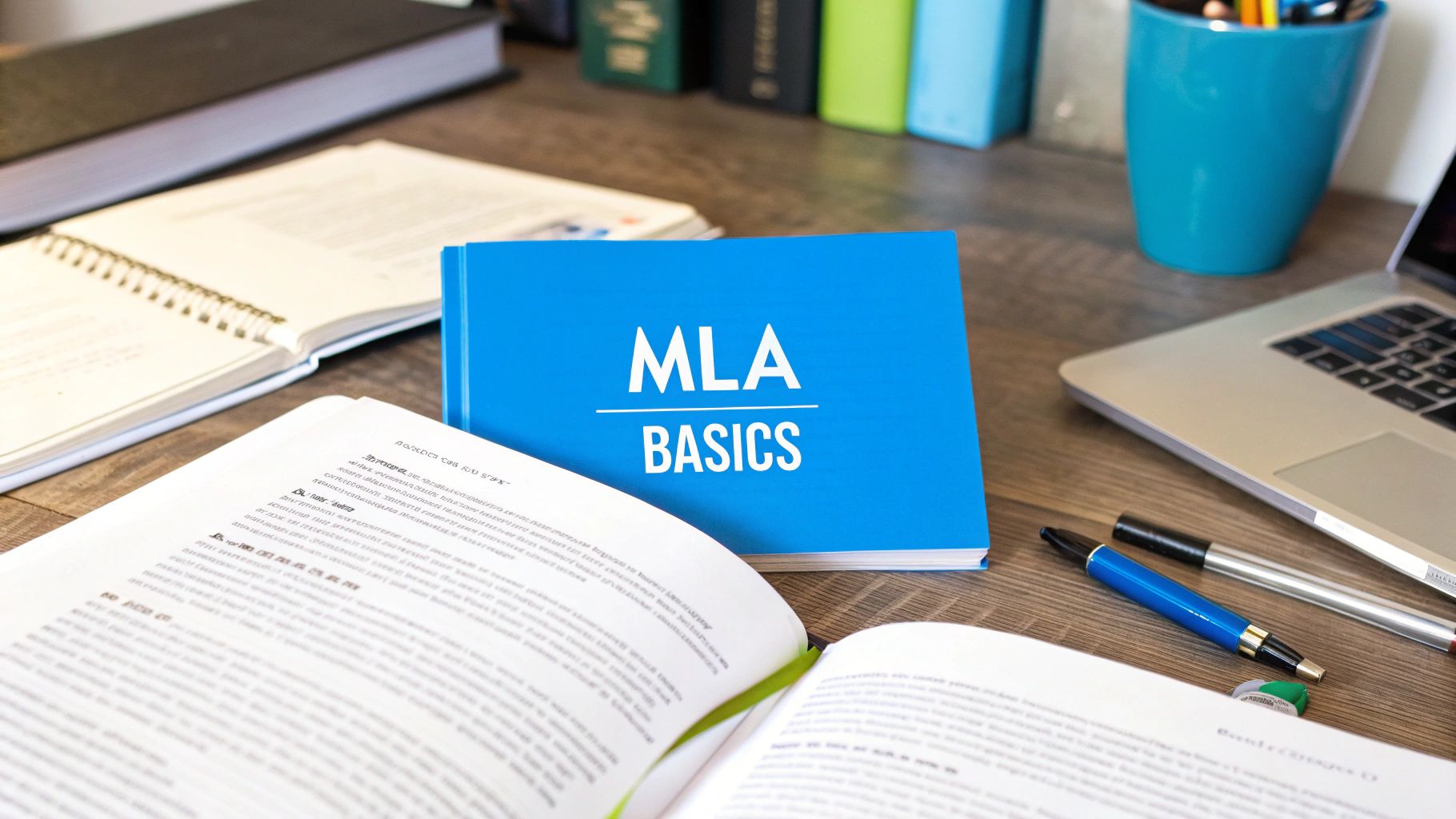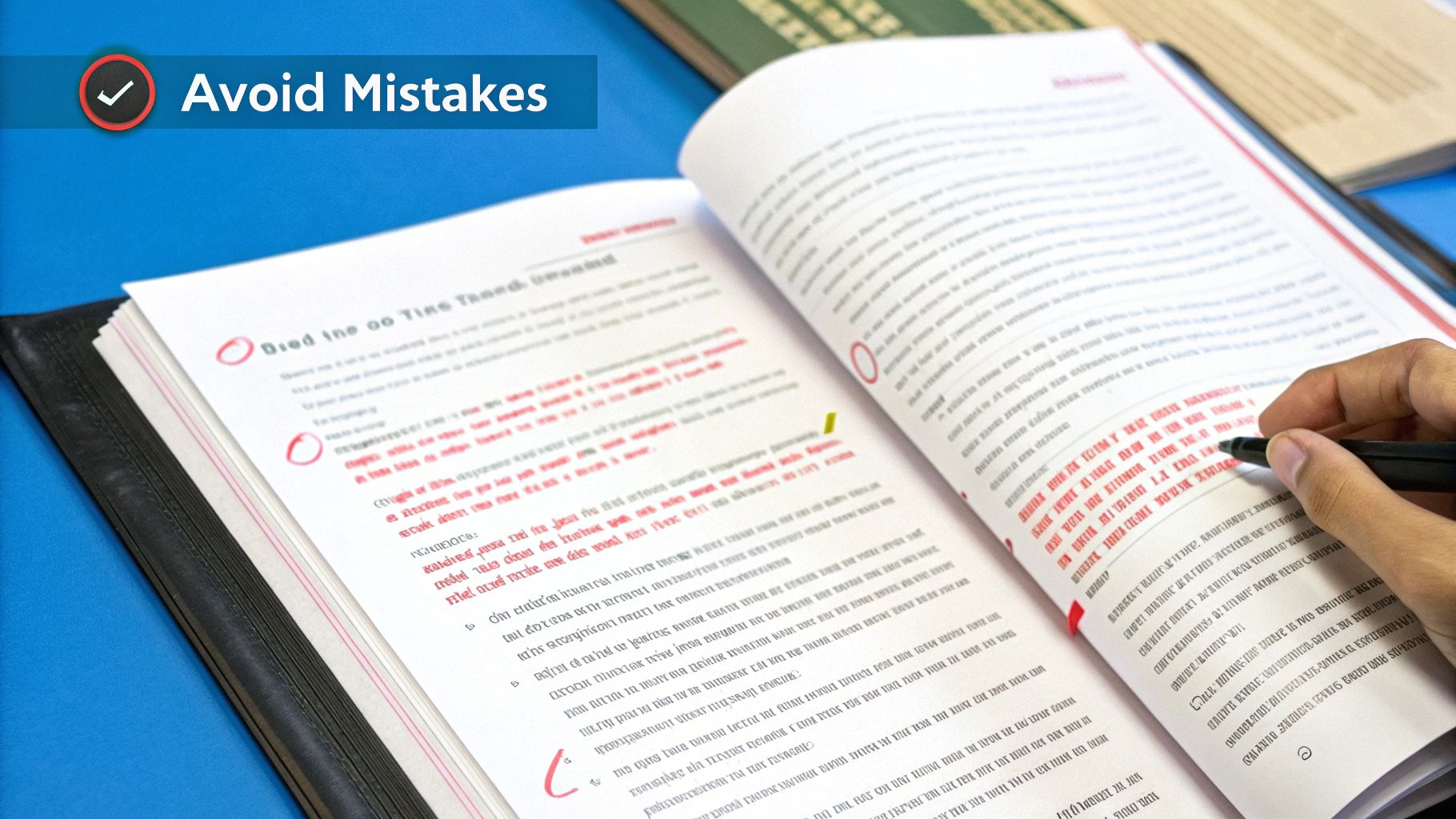Citation Format Guide: Master APA, MLA & Chicago Like a Pro

Why Citation Mastery Changes Everything for Writers
Let's be honest, citations aren't just about dodging plagiarism accusations. They're your secret weapon for building credibility and joining the academic conversation. Think of it this way: when you cite your sources correctly, you're showing your readers you've done the legwork. You're not just tossing around opinions; you're backing them up with solid evidence.
This instantly boosts your credibility and makes your writing way more persuasive. You go from someone simply stating information to a researcher engaging with existing scholarship.
This change in how you're perceived is huge for any writer, especially in academic or professional fields. Proper citations show respect for other researchers and their contributions. They also create a roadmap for others to trace your research and dive deeper into the topics you've explored.
This interconnectedness is at the heart of academic discourse, allowing knowledge to be shared, scrutinized, and expanded upon. For example, picture yourself writing a research paper on social media's influence. By citing relevant studies and statistics, your arguments become stronger and resonate more powerfully with your audience.
Accurate citation also has implications beyond individual projects. The importance of proper citation has become a global focus, especially with the rise of digital publishing and information sharing. The European Union's 2022 'Data Citation Guide' underscores this, highlighting how proper citation makes data reuse easier for millions of users worldwide. Discover more about data citation best practices. Mastering a citation format guide isn't just about checking boxes; it's about being a responsible participant in the global exchange of information.
Beyond academia, understanding citation makes your professional writing stronger. Whether it's journalism, business reports, or grant proposals, citing verifiable sources adds weight to your claims. It builds trust with your audience and demonstrates that your recommendations are grounded in solid research, not just intuition. Citation mastery isn't just about formatting; it’s about showing your integrity and making a meaningful contribution to your field.
Cracking the APA Code Without the Confusion
That infographic above? Think of it as your zen garden for APA citations – a clean workspace, a helpful manual, and clear examples. It's a visual reminder that with the right resources and a grasp of the fundamentals, APA formatting isn't nearly as scary as it seems.
Let's get down to brass tacks. Honestly, the biggest obstacle with APA is often just the perception of its complexity. It's less about memorizing everything and more about understanding the underlying logic. Think of it like learning to drive: overwhelming at first, but second nature with practice.
Citing a Journal Article
Take citing a journal article, for instance. APA focuses on author, date, and title, highlighting who wrote it, when, and what it’s about. This core structure repeats across different source types, offering a consistent framework. Accurate citations are crucial, especially when you're working with statistics in academic writing. Thankfully, citation managers exist to simplify this process. They're lifesavers for organizing and formatting citations, pulling info from websites, databases, and all sorts of sources. Find helpful tips on citation managers and citing data.
Handling Tricky Citations
APA also has your back when things get complicated. Missing a date? Twenty authors? APA provides specific guidelines for these situations, ensuring your citations are complete and accurate. This attention to detail not only avoids inaccuracies but also boosts your credibility. Mastering these nuances can smooth out your research process, making your writing more professional and strengthening your voice as a researcher.
To give you a quick and easy reference, I’ve put together this handy table summarizing the key elements of APA style:
APA Citation Quick Reference
Comparison of APA citation formats for different source types with examples
| Source Type | In-Text Citation | Reference List Format | Example |
|---|---|---|---|
| Journal Article | (Author, Year) | Author, A. A., Author, B. B., & Author, C. C. (Year). Title of article. Title of Journal, Volume(Issue), pages. DOI | (Smith, 2023) Smith, J. (2023). The impact of social media. Journal of Communication, 50(2), 100-120. doi:10.xxxx/xxxxx |
| Book | (Author, Year) | Author, A. A. (Year). Title of work. Publisher. | (Jones, 2022) Jones, P. (2022). The art of writing. Oxford University Press. |
| Website | (Author or Organization, Year) | Author, A. A. or Organization Name. (Year, Month Day). Title of webpage. Website Name. URL | (American Psychological Association, 2024) American Psychological Association. (2024, January 1). Understanding APA style. APA.org. https://www.apa.org |
This table provides a snapshot of common APA citations. Notice how the author and year are always prominent, maintaining that consistency we talked about. Keep this table handy as you work on your citations – it's a great quick reference.
MLA Format That Actually Makes Sense
MLA style can feel a little overwhelming at first, but honestly, it's all about being clear and giving credit where it's due. The Modern Language Association designed this format with authorship and easy access in mind. Every little detail, from those in-text citations to the Works Cited page, has a purpose.
Take a look at this screenshot from Purdue OWL showing the basic MLA page layout:
See how clean it looks with the double-spacing, the header, and the clear title? This consistent structure makes MLA papers easy to read. It puts the focus right where it should be: on the content.
Think of it like a well-designed website. Clear headings, consistent fonts, and a logical layout make information easy to find. MLA formatting does the same thing for academic papers. It helps your readers focus on your ideas, not on deciphering a complicated citation system. Imagine reading a literary analysis, for example. Well-placed MLA citations let you absorb the writer’s points without any distracting hiccups.
Handling Modern Sources and Complex Citations
One slightly tricky part of MLA is the idea of "containers." A container is simply the larger work that holds the source you’re citing. So, a journal article is in a journal, a poem is in a collection, a chapter is in a book – you get the idea. It might seem confusing at first, but it’s there to help your reader understand where your source comes from.
Let’s be honest, sources these days can be all over the place. Think social media posts, YouTube videos, even comments on online articles. MLA actually has ways to cite all of them. The key is understanding the basic principles and applying them logically. You might even want to check out this article on how Turnitin’s AI detection works for students. It’s a good way to navigate some of these trickier citation situations.
Making MLA Work for You
From my own experience, using MLA format correctly can actually improve your writing. It makes you be really precise about your sources and how you use them. That precision makes your arguments stronger and shows you've done your research. When you master MLA, you're not just following rules; you’re developing skills that will make you a better writer and a stronger academic voice.
Chicago Style: Your Gateway to Professional Scholarship
Chicago style has a reputation for flexibility, but that also means it requires a bit more attention. It’s like having a fully stocked professional kitchen: so many possibilities, but you need to know your way around. The key is understanding the notes-bibliography and author-date systems. Your choice depends on your field. History or literature? Notes-bibliography is likely your go-to. Social sciences? Author-date might be a better fit.
Footnotes and Endnotes: Adding Depth, Not Clutter
Footnotes and endnotes are where Chicago style truly shines. Think of them as little side chats with your reader, a space for extra details, deeper insights, or even a bit of scholarly debate. They add depth without disrupting the flow of your main argument. I once read a history paper where the footnotes were honestly just as interesting as the main text, filled with little-known facts and intriguing connections.
Mastering Unique Sources
Chicago excels at handling those tricky sources that other citation formats stumble over. Archival materials? Personal interviews? Multimedia? Chicago has you covered. This is incredibly helpful in fields like history or the arts, where these less conventional sources are so important. And in today's world with information coming from everywhere, a robust citation guide like Chicago is more crucial than ever. The increase in global data sharing has only amplified this need. Learn more about the impact of data sharing on citations here.
Practical Tips for Consistency
One of the biggest hurdles with Chicago, especially for bigger projects, is staying consistent. With so many options, it's easy to get bogged down. My personal tip? Create a style sheet. It's basically a cheat sheet where you list your formatting choices for every source type. This saves so much time and keeps everything organized. It's like having a backup of all your formatting choices, so you don’t have to keep starting from scratch. Chicago offers a lot of power, and with a little practice, you can master it to create polished, professional work.
Smart Tools and Strategies That Actually Work
So, we've covered the why and the how of different citation styles. But let's talk practical application. Having a good citation guide is like having a recipe – helpful, but not enough. You also need the right tools, like a sharp set of knives or a reliable blender, to make things really come together.
Citation Managers: Your Secret Weapon
Citation managers like Zotero, Mendeley, and EndNote can be absolute lifesavers. They're like having a personal librarian who organizes your references and automatically formats citations. I used Zotero for a massive research paper once, and it honestly saved me hours.
But here's the thing: don't blindly trust them. I learned the hard way that sometimes website metadata can be wonky. Always double-check the details. Think of it as a helpful assistant, not a replacement for your own careful review. You might even find some parallels with using AI writing tools – our guide on humanizing ChatGPT results talks about similar challenges in ensuring accuracy.
Browser Extensions and Plugins: The Good and the Bad
Browser extensions and plugins for word processors can also be handy for grabbing citations as you research. However, some are clunky and can mess with your formatting. It's really a personal preference thing. What works perfectly for me might be a total nightmare for you. Experiment and find your perfect match.
Building Your Citation Arsenal
Your citation resources are your toolbox. You'll have your go-to tools and specialized ones for specific jobs. Build a system that works for you and can grow with your research needs. Maybe you organize by project, by keyword, or even by source type. Find what clicks.
And remember, tech fails. Knowing how to manually create a citation is like knowing how to change a tire. You might not need it often, but when you do, you'll be glad you have the skill. The goal isn't to become completely dependent on tools, but to use them strategically to make citing more efficient and, most importantly, accurate.
To help you choose the right tools, I've put together a comparison table:
Citation Tool Comparison: Feature comparison of popular citation management tools
| Tool Name | Free Version | Key Features | Best For | Limitations |
|---|---|---|---|---|
| Zotero | Yes | Open-source, browser integration, PDF management | Researchers, students | Can be complex for beginners |
| Mendeley | Yes | Note-taking, social collaboration, mobile app | Collaborative projects, literature reviews | Limited free storage |
| EndNote | No (Free trial) | Advanced features, large library support, integration with Microsoft Word | Large-scale projects, professional researchers | Costly subscription |
This table gives a quick overview of some popular options, highlighting their strengths and weaknesses. Zotero’s open-source nature and robust features make it a favorite for many, while Mendeley's collaboration tools shine for group projects. EndNote, while powerful, comes with a price tag. Consider your needs and budget when making your choice.
Avoiding the Mistakes That Trip Up Everyone
Even seasoned researchers sometimes slip up on citations. Trust me, I've been there. But knowing the common traps can seriously boost your citation game. Let’s look at a few real-life examples of how things can go sideways.
The Case of the Missing Date
I once reviewed a paper where several citations were missing publication dates. It seems small, but it really weakens your citation. How can anyone verify if the information is current? It’s like giving someone directions but forgetting the street names. You're in the right neighborhood, but good luck finding the exact house.
Remember to always double-check for those dates! Accuracy is key.
The Perils of "Time-Saving" Shortcuts
We've all done it – copied and pasted citations, thinking we'll fix them later. Let's be honest, "later" rarely happens. This "shortcut" almost always creates more work in the long run. Inconsistent formatting makes your work look sloppy. It’s like having a beautifully set table with mismatched forks and spoons. It just throws everything off. Using a tool like Grammarly can help keep your writing consistent and polished.
The Gray Areas of Citation
Citing a source you found within another source (a secondary source) can be tricky. Each style guide (APA, MLA, Chicago) has its own rules. Get this wrong, and you risk misrepresenting the information. Paraphrasing is another area where people stumble. Just changing a few words isn't enough. You need to truly understand the original meaning and express it in your own way. I always compare my paraphrased text to the original to make sure I haven't accidentally plagiarized. If you're worried about AI detection when paraphrasing, check out this helpful guide: Bypass AI Detection.
Proofreading for Perfection
Finally, train yourself to spot citation errors. When you proofread, specifically focus on your citations. Are they consistent? Is any information missing? Is the formatting correct? This targeted approach can save you a lot of trouble later. It’s like polishing a gem – that final attention to detail makes it shine. By understanding these common mistakes and becoming a citation proofreading pro, you'll present your work with confidence and accuracy. Trust me, it's worth the effort.
Building Long-Term Citation Confidence
Citation mastery isn't just about finishing your next paper. It's about building a skill you'll use throughout your academic and professional life. It's like learning a language: the initial effort pays off big time, opening doors to new opportunities.
This means learning to be adaptable. Citation formats change, and new source types pop up all the time. Remember trying to cite a TikTok video a decade ago? Now it's common. Staying current with a solid citation format guide is crucial. You might also find our article on avoiding AI detection in writing helpful, as it covers adapting to new writing technologies.
Sharing Your Citation Expertise
Knowing how to cite well also means you can help others. Imagine mentoring a classmate or helping a colleague refine their work. Sharing your knowledge not only reinforces your own understanding but also builds a culture of accurate and ethical scholarship. Think about when someone helped you with a tricky formatting question – pay it forward!
Citation and Your Reputation
Citing sources consistently and accurately builds your reputation as a thorough and trustworthy researcher. It shows respect for other scholars and strengthens the integrity of your own work. This is important in any field, whether you're in academia, journalism, or business.
Here’s a screenshot from the MLA Style Center website, a fantastic MLA resource:
Notice how the site emphasizes clarity. MLA style is all about making information clear and easy to digest, which reflects the values of the humanities.
A Roadmap for Continued Growth
Finally, keep learning! Citation isn't a skill you learn once and forget about. New resources and tools are always being developed. Connect with other writers who value proper citation. Join online communities, attend workshops, or just chat with your librarian. Building a support network is invaluable for staying up-to-date and confident in your citation skills. This ongoing learning not only improves your writing but also makes your contributions to the academic community stronger. Boost your writing with Word Spinner, an AI-powered platform that simplifies content creation and ensures originality. Start your free trial today!


